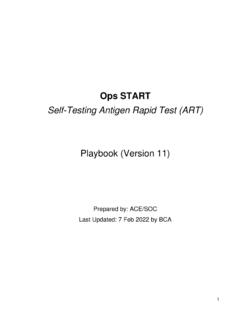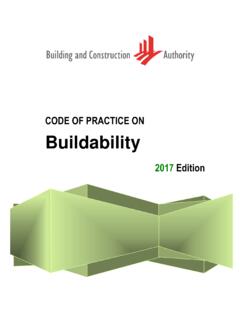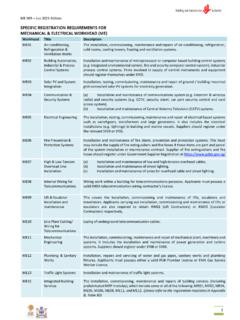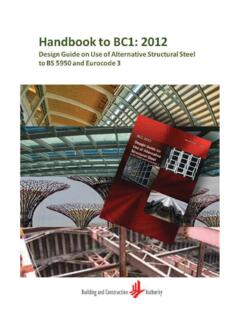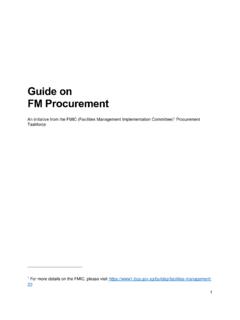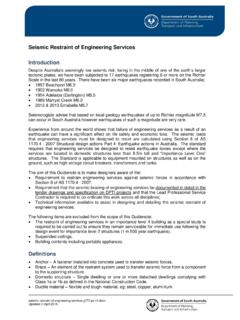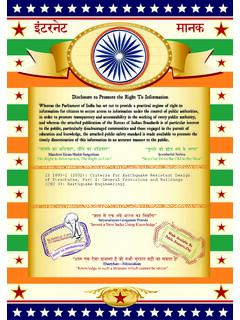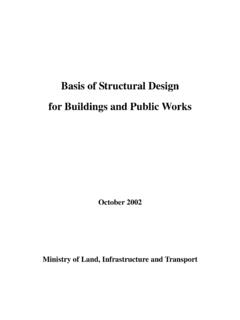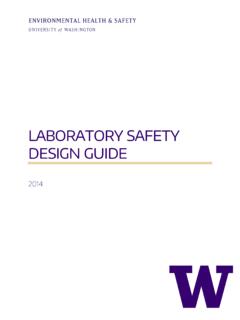Transcription of BC3-2013 - Guidebook for Design of Buildings in Singapore ...
1 Guidebook for Design of Buildings in Singapore to Requirements in SS EN 1998-1 BC3: 2013 (25 Apr 2013) Page 1 of 26 BC3: 2013 Guidebook for Design of Buildings in Singapore to Requirements in SS EN 1998-1 (25 Apr 2013) Page 2 of 26 NOTE 1. Whilst every effort has been made to ensure accuracy of the information contained in this Design guide, the building and Construction Authority ( BCA ) makes no representations or warranty as to the completeness or accuracy thereof. Information in this Design guide is supplied on the condition that the user of this publication will make their own determination as to the suitability for his or her purpose(s) prior to its use.
2 The user of this publication must review and modify as necessary the information prior to using or incorporating the information into any project or endeavour. Any risk associated with using or relying on the information contained in the Design guide shall be borne by the user. The information in the Design guide is provided on an as is basis without any warranty of any kind whatsoever or accompanying services or support. 2. Nothing contained in this Design guide is to be construed as a recommendation or requirement to use any policy, material, product, process, system or application and BCA makes no representation or warranty express or implied. NO REPRESENTATION OR WARRANTY, EITHER EXPRESSED OR IMPLIED OF FITNESS FOR A PARTICULAR PURPOSE IS MADE HEREUNDER WITH RESPECT TO INCLUDING BUT NOT LIMITED, WARRANTIES AS TO ACCURACY, TIMELINES, COMPLETENESS, MERCHANTABILITY OR FITNESS FOR A PARTICULAR PURPOSE OR COMPLIANCE WITH A PARTICULAR DESCRIPTION OR ANY IMPLIED WARRANTY ARISING FROM THE COURSE OF PERFORMANCE, COURSE OF DEALING, USAGE OF TRADE OR OTHERWISE, TO THE FULLEST EXTENT PERMITTED BY LAW.
3 In particular, BCA makes no warranty that the information contained in the Design guide will meet the user s requirements or is error-free or that all errors in the drawings can be corrected or that the drawings will be in a form or format required by the user. 3. In no event will BCA be responsible or liable for damages of any kind resulting from the use or reliance upon information or the policies, materials, products, systems or applications to which the information refers. In addition to and notwithstanding the foregoing, in no event shall BCA be liable for any consequential or special damages or for any loss of profits incurred by the user or any third party in connection with or arising out of use or reliance of this Design guide. (25 Apr 2013) Page 3 of 26 Contents Contents.
4 3 Foreword .. 4 Acknowledgement .. 5 1. General Philosophy .. 6 2. building Height and Ground Type Classification .. 8 3. Design Seismic Actions .. 10 4. Analysis Methods .. 14 5. Combination of Actions and Accidental Torsional Effects .. 20 6. Foundation Design .. 22 7. Drift Limitation .. 23 8. Minimum Structural Separation for Buildings Above 20m High .. 24 (25 Apr 2013) Page 4 of 26 Foreword This Guidebook for Design of Buildings in Singapore to Requirements in SS EN 1998-1 referred to as BC3: 2013 gives provisions for the structural Design against seismic actions and is to be read in conjunction with the Singapore National Annex to SS EN 1998-1: 2012. (25 Apr 2013) Page 5 of 26 Acknowledgement The building and Construction Authority of Singapore (BCA) would like to thank the members of the Workgroup formed to develop this Guidebook for their valuable contributions.
5 Workgroup: Chairman Prof Pan Tso-Chien Nanyang Technological University Members Prof T Balendra formerly National University of Singapore Dr Jack Pappin Arup Dr Juneid Qureshi Meinhardt Singapore (Pte) Ltd K Thanabal BCA Lung Hian Hao BCA Ng Man Hon BCA (25 Apr 2013) Page 6 of 26 1. General Philosophy New Buildings that are above 20 metres in height and existing Buildings undergoing very major addition or alteration worksA founded on certain Ground Types shall be checked for an enhanced robustness consideration to cater for impact of Seismic Actions due to distant earthquakes with a probability of exceedance of 10% in 50 years according to the methodology outlined in the flowchart in Figure 1. This requirement will apply to the following types of building and the corresponding Ground Types (determined as per paragraph ): Special buildingsB on Ground Types C , D or S1 and Ordinary buildingsC on Ground Types D or S1 As Singapore is in a low seismicity region, Ductility Class Low (DCL)D Design and detailing can be adopted for reinforced concrete, precast concrete, structural steel or composite Buildings .
6 A Very major addition or alteration works refers to: addition of floors on existing Buildings that results in the building attaining a height greater than 20 metres, or structural works affecting key structural elements supporting total tributary area of more than 60% of the total structural floor area of a building of height greater than 20 metres, or additions of new structural floor areas of more than 60% of the existing total structural floor area of a building of height greater than 20 metres. B Special Buildings refer to hospitals, fire stations, civil defence installations, Government Ministry offices and institutional Buildings . C Ordinary Buildings are Buildings other than those classified as Special Buildings . D DCL steel reinforcement detailing for reinforced concrete structures would follow the requirements of SS EN 1992-1-1 ( Design of concrete structures General rules and rules for Buildings ) and in conjunction with Clause (1)P of SS EN 1998-1.
7 For Buildings of structural steel or composite construction, the element Design shall follow the relevant parts of SS EN 1993 ( Design of steel structures) or SS EN 1994 ( Design of composite structures) respectively. (25 Apr 2013) Page 7 of 26 Figure 1 Flowchart to determine whether enhanced robustness consideration applies building height, H > 20 metres?NSeismic Action need not be considered in Design Ordinary building on Ground Type Class D or S1 ? or Special building on Ground Type Class C , D or S1 ? Drift limitation check according to Clause 7and Minimum structural separation check according to Cause 8 Seismic Action need not be considered in designGround Type within building footprint determined according to Clause height, H determined according to Clause Action determined according to Clause 3 andClause 4using where appropriate, either Lateral Force Analysis Method according to Clause Modal Response Spectrum Analysis Method according to Clause analysed according to combination of actions in Clause 5 and foundation Design carried out according to Clause 6 (25 Apr 2013) Page 8 of 26 2.
8 building Height and Ground Type Classification The building height, H shall be taken from the foundation or top of a rigid basement to the topmost habitable structural floor levelE, as shown in Figure 2. Figure 2 - Example of determination of topmost habitable structural floor level The Ground Type within the footprint of structurally independent buildingF shall be determined firstly by computing the value of using either soil parameter of shear wave velocity (vs,30), standard penetration test (NSPT(blows/300mm)) or undrained shear strength (cu) in the upper 30m soil depth as: where is equal to 30m; is the soil parameter (vs,30, NSPT(blows/300mm) or cu); and is the thickness of layer between 0 and 30m. E Topmost habitable structural floor level refers to topmost floor accessible for usage.
9 F Structurally independent building refers to a building that depends only on the structural framing within its own footprint for stability and resistance against Design actions. (25 Apr 2013) Page 9 of 26 The computed value of is then used to determine the Ground Type from Table 1 below. Value of as computed from paragraph for soil in the upper 30m Ground Type Description of stratigraphic profile Shear-Wave Velocity. vs,30 (m/s) NSPT (blows/30cm) Undrained Shear Strength, cu (kPa) > 800 Not applicable Not applicable A Rock or other rock-like geological formation, including at most 5 m of weaker material at the surface. 360 - 800 > 50 > 250 B Deposits of very dense sand, gravel, or very stiff clay, at least several tens of metres in thickness, characterised by a gradual increase of mechanical properties with depth.
10 180 - 360 15 - 50 70 - 250 C Deep deposits of dense or medium-dense sand, gravel or stiff clay with thickness from several tens to many hundreds of metres. < 180 < 15 < 70 D Deposits of loose-to-medium cohesionless soil (with or without some soft cohesive layers), or of predominantly soft-to-firm cohesive soils. < 100 < 5 10 - 20 S1 Deposits consisting, or containing a layer at least 10 m thick, of soft clays/silts with a high plasticity index (PI > 40) and high water content. Table 1 Determining Ground Type from computed value of In determining the Ground Type, (a) the top 30m soil depth is taken from the existing ground level even if the development requires excavations for basement construction; (b) if more than one of the 3 soil parameters mentioned in table above are available, the most onerous Ground Type determined from these soil parameters shall be adopted; (c) the most onerous Ground Type shall be adopted if there are different Ground Types spatially distributed as determined from various site investigations within the footprint of a building ; and (d) these rules shall apply regardless of whether the building is founded on piles that extend to hard soil stratum or not.
